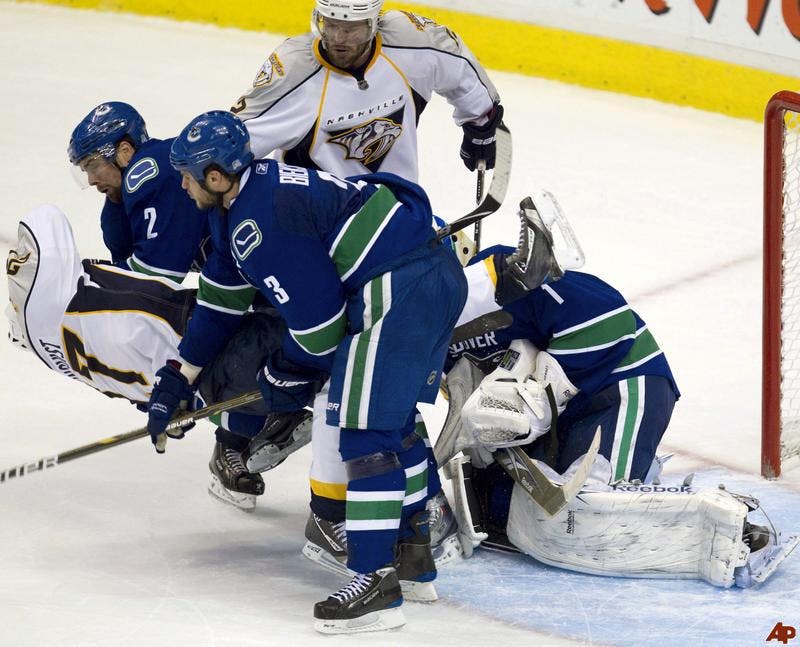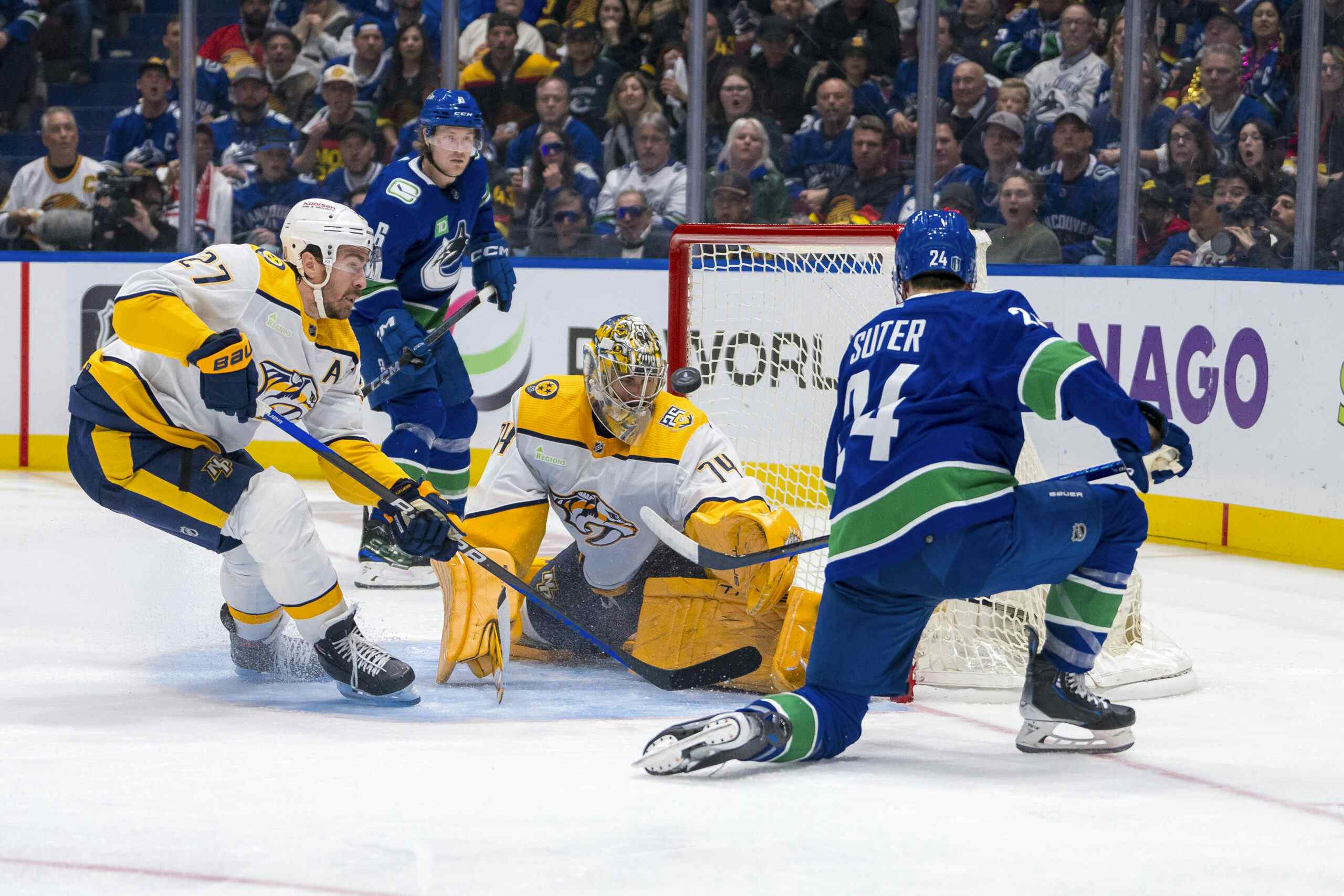Hamhuis, Bieksa and Heavy Lifting

Kevin Bieksa and Dan Hamhuis: just a couple of guys who know how to clear the crease.
Though he’s performed as well, or nearly as well, as any defenseman on the roster over the past couple of seasons, Kevin Bieksa’s play has been a source of perpetual frustration for many Canucks fans. You know a fanbase has an irrational, bi-polar relationship with a specific player when that player begins to accrue false narratives that "explain" their play. For Roberto Luongo, it’s that he’s a choker. For Mason Raymond, it’s that he’s a "perimeter player." For Kevin Bieksa, you can pick your poison – he only plays well in contract years is a popular one, but the idea that he’s not good at defense (demonstrably untrue) is another favorite.
The way the story is usually told, Kevin Bieksa’s defensive play turned around when Dan Hamhuis arrived in Vancouver. Once Hamhuis arrived, Bieksa stopped his positional "swimming" in Vancouver’s own end, cut down on his unforced errors with the puck and was magically transformed into a reliable defensive presence along Vancouver’s blue-line.
Read past the jump for more.
Here’s what we know for sure: combined, Bieksa and Hamhuis are one of the league’s best hybrid shutdown pairings. They can beat opponents with their steady, physical defensive play, but they can also pin the puck in the offensive end and help the team generate offense. They can key the rush with crisp zone-exit passes, and they can suffocate the other team while minimizing the number of corsi-events surrendered. In short, they’re like the Super Mario character in any Nintendo Party Game (Mario Kart, Mario Tennis etc.): fast enough to beat the likes of DK with speed, strong enough to overpower Yoshi.
What I’m interested in taking a quick, objective gander at, however, is the notion that Dan Hamhuis does the heavy-lifting defensively when the two players are paired together at even-strength. Does the evidence indicate that Hamhuis’ presence on Bieksa’s left side make Bieksa a stingier defensive player? My hypothesis is that this explanation, commonly held by Canucks fans, just doesn’t give Bieksa enough credit. KB3 is, I would argue, a quality defensive option in his own right. Let’s see if the numbers back up that hypothesis!
The following stats are taken from David Johnston’s site stats.hockeyanalysis.com, and what follows is a "With or Without You" (WOWY) table breaking down how Bieksa and Hamhuis perform when they’re on the ice together at five-on-five, and when they’re on the ice separately (as a result of injury, or AV’s latest blender binge, or what have you). I’ve broken their numbers down based on both goals (for those of you who hate Corsi) and Corsi (because it’s really useful and if you don’t believe in its qualified utility, you’ve got your head in the sand) and rated those numbers per sixty minutes. Here’s the table:
| EV TOI | Goals For/60 | Goals Against/60 | GD/60 | Corsi Events For/60 | Corsi Events Against/60 | Corsi Differential/60 | |
|---|---|---|---|---|---|---|---|
| Bieksa and Hamhuis | 1638:50 | 3.26 | 1.9 | +1.36 | 59.84 | 49.76 | +10.07 |
| Just Bieksa | 879:30 | 1.91 | 2.39 | -0.48 | 59.7 | 51.3 | +8.39 |
| Just Hamhuis | 855:58 | 2.52 | 2.6 | -0.08 | 61.46 | 48.49 | +12.97 |
A couple of interesting things to point out. First off is that both Bieksa and Hamhuis have been extraordinarily steady possession players over the past couple of seasons. The Canucks still need another tough minutes defenseman (or two), but at the top of the blueline depth chart: they’re rock solid.
Secondly, the idea that Hamhuis does the heavy lifting defensively appears to carry weight. After all, the Canucks generate more Corsi events with just Hamhuis on the ice, than with just Bieksa, and surrender fewer against as well. In fact, the team’s Corsi differential per sixty minutes with Hamhuis on the ice, isn’t just better than the team’s differential with just Bieksa on the ice, it’s even better than it is when the team rolls with their ace "shutdown pairing." It should be noted, however, that if you look at the WOWY numbers when corrected for zone-starts, Bieksa performs significantly better than he does in the above table (that suggests to me that Bieksa plays tougher minutes without Hamhuis, than Hamhuis does without Bieksa – but we can’t know that with any strong degree of certainty).
Where the discrepancies emerge is when you look at goals for and against per sixty minutes. Contrary to the idea that Hamhuis is the steadier defensive option among the twosome, the Canucks surrender fewer goals against per sixty with just Bieksa on the ice, than with just Hamhuis. The margin isn’t big, in fact, I’d call it statistical noise especially since this piece of analysis doesn’t benefit from the on-ice shooting percentage data, zone-starts or quality of competition, but it’s interesting. And it’s interesting because it directly contradicts the idea that Bieksa is a sieve, who is only reliable defensively as a result of his partnership with Hamhuis.
The most important thing to take away from this, however, is that the Canucks surrender significantly fewer goals when both Bieksa and Hamhuis are deployed together, and score significantly more. In terms of goal differential per sixty, both players have been in the red over the past two seasons when separated, but they’ve been dominant when paired together.
Ultimately, it’s true that Hamhuis is the better shot preventer, the better all around possession player, and does the "heavy-lifting" on Vancouver’s ace defensive pairing. But in terms of what really matters – which, get this, is goals for and against – Hamhuis benefits significantly from his partnership with Kevin Bieksa. The two have a symbiotic type of chemistry.
Recent articles from Thomas Drance





